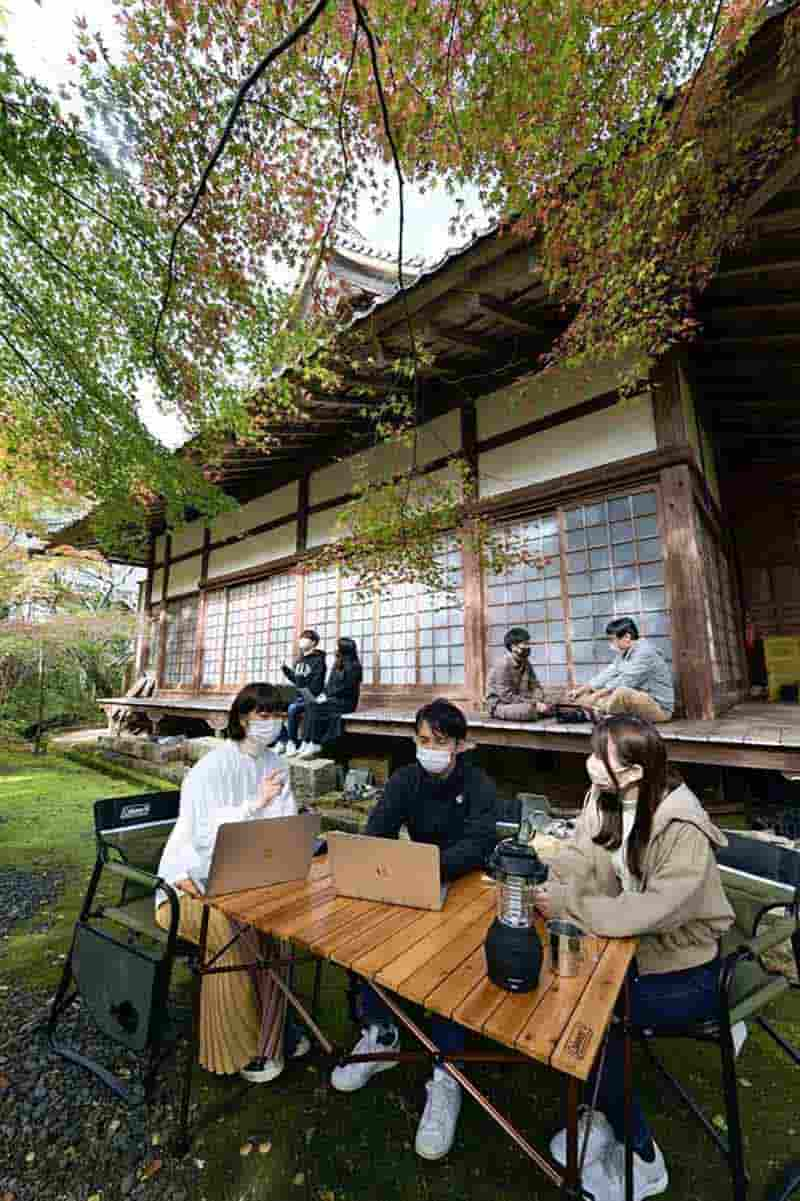
Workers, including those from an IT firm in Osaka, are seen teleworking at Jinzoji temple in Kameoka, Kyoto Prefecture.
November 22, 2021
OSAKA — Within the past two years, two mash-up words related to employment have barged their way into common usage: “telework” and “workation.” By now, just about everyone understands that telework is work done outside of a conventional office, and a workation is teleworking somewhere that you could go to on vacation.
The usual places for workations are resorts, theme parks and the like, but if the efforts of some temples are successful, a new term may come to the fore: “tera-work.”
As the word implies, tera-work means teleworking in the precincts of a temple, with the attraction of being surrounded by an atmosphere quite serene compared with daily life. People who have tried tera-working say they can concentrate better on their work.
Having seen both the number of temple visitors and money spent within the precincts plunge amid the COVID-19 crisis, some temples have high hopes that tera-work will catch on.
‘Feel so refreshed’
Within the tree-enclosed grounds of Jinzoji temple in Kameoka, Kyoto Prefecture, several desks, chairs, and portable Wi-Fi devices have been placed for teleworking. Young workers were seen looking into the displays of their personal computers, sitting wherever they like, such as under the eaves of the main building of the temple.
The seven mostly young workers were from TAM inc., an IT firm based in Kita Ward, Osaka. One of them, age 26, said with a smile: “In a sacred atmosphere, I can do well with my work. As I ramble through the woods within the precincts of the temple, I feel so refreshed.”
After work, the seven employees held a barbecue party.
Revenue plunges
The temple began letting people telework and camp there in July due to the harsh environment surrounding the temple’s operations.
This temple had eked out its expenses through revenue gained from visitors entering the temple for celebrating the New Year and those people visiting there to enjoy the autumn leaves, as well as the money thrown into offertory boxes.
As group visitors to the temple dropped as the COVID-19 crisis dragged, however, its revenue, which would total about ¥1 million in a normal year, dropped markedly. As the temple was unable to raise money to repair leaks in the roof of the main building, it’s now dealing with the leaks by using a waterproof sheet.
The fee for tera-working is ¥2,500 a day. The temple also offers such Buddhist-related services as letting people experience Zen meditation.
In July, about 30 people used the workation service. In August and September, when the state of emergency was in place, the temple refrained from accepting people. During the October-November period, about 60 people are expected to have used the temple for their workations.
Gikei Matsumoto, a 48-year-old deputy chief priest at the temple, senses a good response to the service, saying: “If people stop coming here, our temple, located deep in a mountain, would become dilapidated soon. The workation service has brought about a new style of connection between the temple and young people.”
100 groups in a month
Daitaiji temple in Nachikatsuura-cho, Wakayama Prefecture, started accepting campers into its grounds, primarily from a viewpoint of disaster prevention. Located on high ground, the temple serves as an evacuation site in times of disasters.
In the summer of 2019, it started a lodging service within its grounds, in hopes of enabling evacuees to spend their time as comfortably as possible even in times of emergency. At the same time, the temple began accepting campers.
Such attempts have unexpectedly drawn much attention, in line with the spread of the use of its workation service amid the COVID-19 pandemic.
In August, about 100 groups used the service, with the lodging facility almost fully booked by the year-end. Users bring their own Wi-Fi devices to do their telework, while enjoying the natural surroundings, according to the temple.
Experiencing some Buddhist rituals, such as sutra copying and Zen meditation, has also proved popular among visitors.
Tomi Nishiyama, a 40-year-old chief priest of the temple, said delightedly, “I would be grateful if our temple eventually becomes a presence close to people.”
"Society" POPULAR ARTICLE
-

M4.9 Earthquake Hits Tokyo, Neighboring Prefectures
-

Israeli Tourists Refused Accommodation at Hotel in Japan’s Nagano Pref., Prompting Protest by Israeli Embassy and Probe by Prefecture
-

M7.5 Earthquake Hits Northern Japan; Tsunami Waves Observed in Hokkaido, Aomori and Iwate Prefectures
-

Tsukiji Market Urges Tourists to Avoid Visiting in Year-End
-

High School in Kyoto Says Students Shoplifted during Recent School Trip to Bali, Indonesia
JN ACCESS RANKING
-

Tokyo Economic Security Forum to Hold Inaugural Meeting Amid Tense Global Environment
-

Keidanren Chairman Yoshinobu Tsutsui Visits Kashiwazaki-Kariwa Nuclear Power Plant; Inspects New Emergency Safety System
-

Imports of Rare Earths from China Facing Delays, May Be Caused by Deterioration of Japan-China Relations
-

University of Tokyo Professor Discusses Japanese Economic Security in Interview Ahead of Forum
-

Japan Pulls out of Vietnam Nuclear Project, Complicating Hanoi’s Power Plans

























